Introduction
by: Contact Archeology Inc. (CAI) July 2022
In 2015 the University of West Florida (UWF) declared that they had discovered the site of the 1559 Luna Colony on Pensacola Bay. This proclamation was publicly extolled after only weeks of pedestrian surveys and shovel testing of a previously known archeological site located in East Pensacola Heights. The site was first reported in 1883 by the Smithsonian Institution as a Native village with two burial mounds.
After seven years and over 1,000 excavation units dug on the 25 acre site UWF has still not recovered irrefutable archeological data that proves their initial claim. Although the Spanish settlement involved over 1,500 men, women, and children, no confirmed archeological features such as Spanish structures, burials, fire hearths, and refuse pits have ever been found. However, much speculation has been disseminated by UWF as absolute truth. Amazingly, UWF has claimed they have identified the Luna docking site, the “activity area,”, the designated areas of lots for settlement, and the anchorage of the Luna fleet … all without any hard evidence of any of their claims.
In reality, what has been found at the site is a preponderance of Native pottery sherds mixed with 16th-Century Spanish artifacts. Previous archeological excavations at the site during the 1990s produced the same results, the site is a Native village containing mixed Native and Spanish artifacts in a midden.
Nonetheless, UWF has used the media, not a detailed technical archeological report, to proliferate their “irrefutable” claim. The facts, however, tell another story.
The following pages address specific topics regarding the issue of the untimely proclamation by UWF of the source of the 16th-Century artifacts found at the East Pensacola Heights Site (8Es1) as well as three 16th-Century shipwrecks found offshore of the Native village. The site may be the Luna Colony but, based on the current evidence, the premature claim by UWF remains unsubstantiated.
The Lack of Spanish Features at the Alleged UWF Luna Colony
UWF has not come close to proving their claim that the East Pensacola Heights Site (8Es1) is the location of the Luna Colony. Finding 16th-Century Spanish artifacts mixed with Native artifacts in a general midden is simply not enough scientific evidence to provide proof of a European settlement. It is necessary to expose archeological subsurface features such as irrefutable Spanish structures, burials, firehearths, and refuse pits.
A total of some 1,500 people arrived at their colony site on Pensacola Bay. The historic documents report that people died there, structures were built, fire hearths were lit due to the need for light, cooking, and warmth.
UWF has found none of these necessary features after seven years of digging for them.
The Presence of Archeological Spanish Features at Santa Elena and St. Augustine
Two Spanish settlements on the east coast of South Carolina and Florida, Santa Elena (1565) and Saint Augustine (1566), that generally date to the same time period of the Luna Expedition (1559) in Northwest Florida provide excellent examples of the types of archeological features needed to prove the location of the Luna Colony. The University of West Florida has failed to produce such features even after seven years and over a thousand excavation units. The illustrations at the end of this article clearly show the types of archeological features needed to prove a 16th-Century Spanish settlement rather than a Native town. The University of West Florida has found nothing akin to these features at their claimed Luna Colony location at the East Pensacola Heights Site.
The Native Village and Burial Mounds at the East Pensacola Heights Site
The East Pensacola Heights Site (1Es1) was first discovered and reported by the Smithsonian Institution in the 1880s. It was reported to be a Native village with two associated burial mounds. The Smithsonian returned to the site in the 1940s to find the burial mounds destroyed but the village midden was still present. The University of West Florida (UWF) records that seventy percent of the artifacts that they have recovered are Native in origin. The point is that the site is definitely that of a Native occupation. UWF is downplaying the importance of the presence of the Native village and burial mounds, and over emphasizing the Spanish artifacts. In fact, some of the Spanish artifacts being found by UWF could have come from the Native burial mounds that were mechanically leveled, and spread out along with crushed Spanish and Native artifacts during the 1940s residential constructions.
The Historic Documents of the Location of the Luna Colony
The chronicles of the Luna Expedition do not mention a Native Village at their colony on Pensacola Bay. The chronicles do mention a Native village at their interior settlement on the Alabama River (Nanipacana), therefore the deduction is that the Luna Colony was not established at a Native village, yet UWF maintains that the Luna Colony is located in the middle at a Native village on Pensacola Bay.
The Spanish Shipwrecks Offshore of the East Pensacola Heights Site
The Florida Bureau of Archeological Research (BAR) discovered a 16th-Century Spanish galleon shipwreck offshore of the East Pensacola Heights Site in 1992. Roger Smith was told by the University of West Florida that searching for Luna shipwrecks was futile. Dr. Smith found his shipwreck anyway.
Later, UWF found two more shipwrecks of the period. All three shipwrecks were found on a shallow sandbar, off of the East Pensacola Heights Site, the ships having been washed ashore by a hurricane that devastated the fleet of the Luna Expedition.
The Luna fleet of ships with 1500 people onboard sailed into Pensacola Bay on August 15, 1559. They found a good anchorage for the fleet of galleons, naos, caravels, barks, and other smaller ships. An anchorage of the fleet of the period was critical for their survival. The ships were their link to safety back home if things went bad. The anchorage had to be deep enough to provide enough water for deep drafted vessels such as the galleons and naos. It also had to be close enough to shore to provide easy access to the colony.
A major hurricane hit the fleet at its anchorage on September 19th of 1559 during the night. The hurricane blew from all directions for twenty four hours. It decimated the Luna fleet. It was reported that anchor lines were snapped and the ships were blown all over the bay or sunk where they were anchored.
The University of West Florida cannot reasonably claim the presence of the Spanish shipwrecks as viable evidence of their Luna Colony claim. The original anchorage of the Luna fleet needs to be found.
The following pages present illustrations and comments concerning information relative to the East Pensacola Heights Site as well as two other 16th-Century Spanish settlements on the Atlantic coast (Santa Elena and St. Augustine).
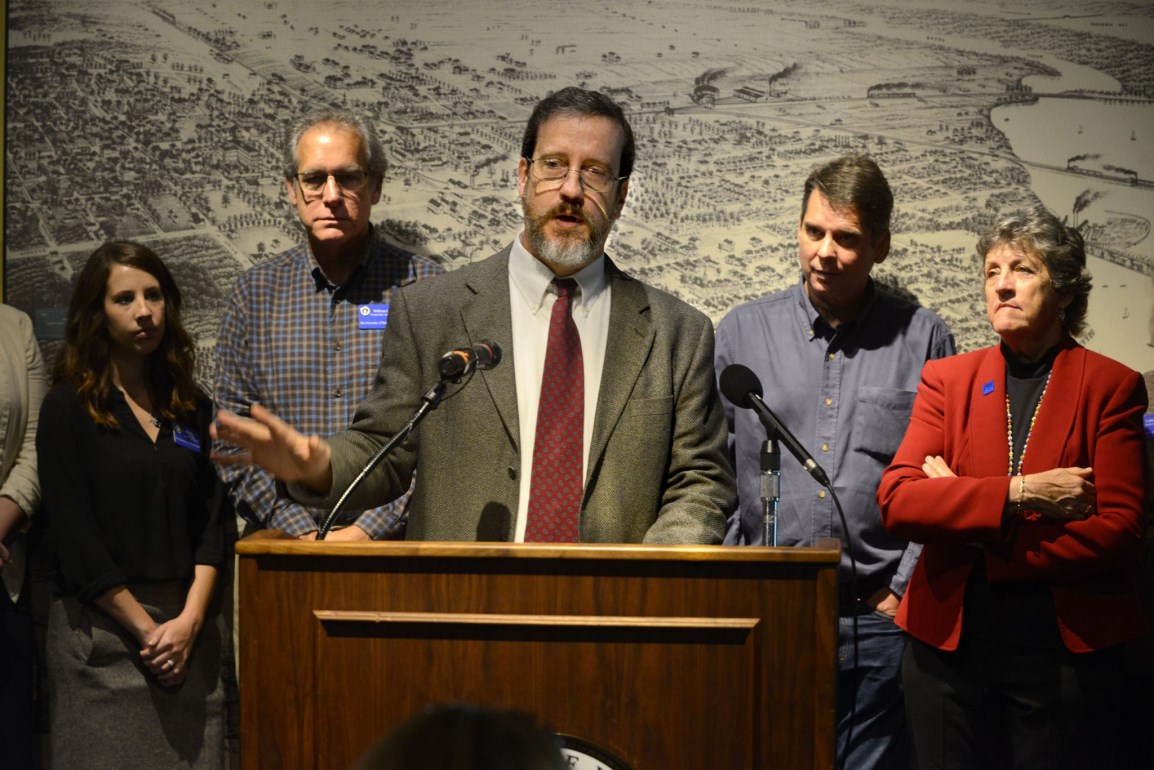
UWF press conference announcing the “alleged” discovery of the Luna Colony.
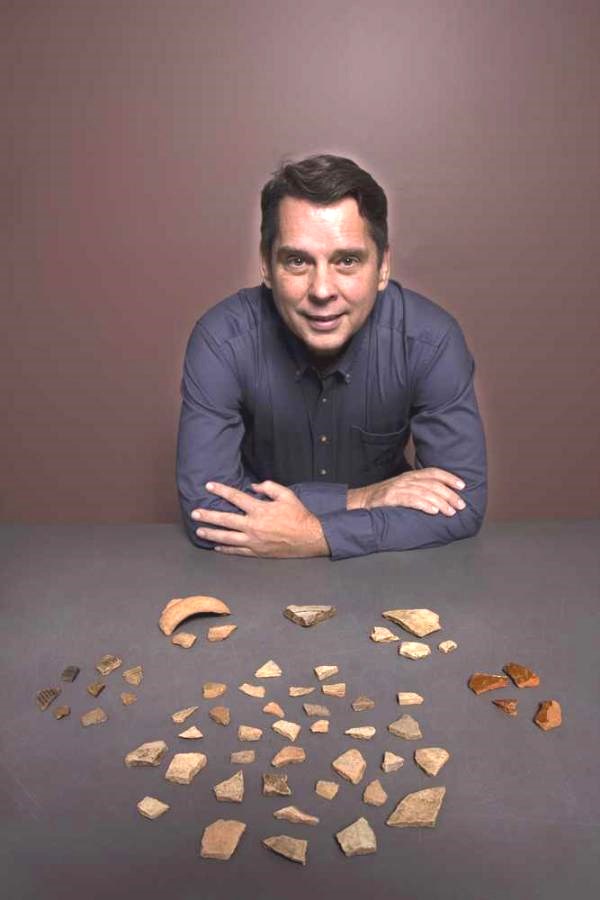
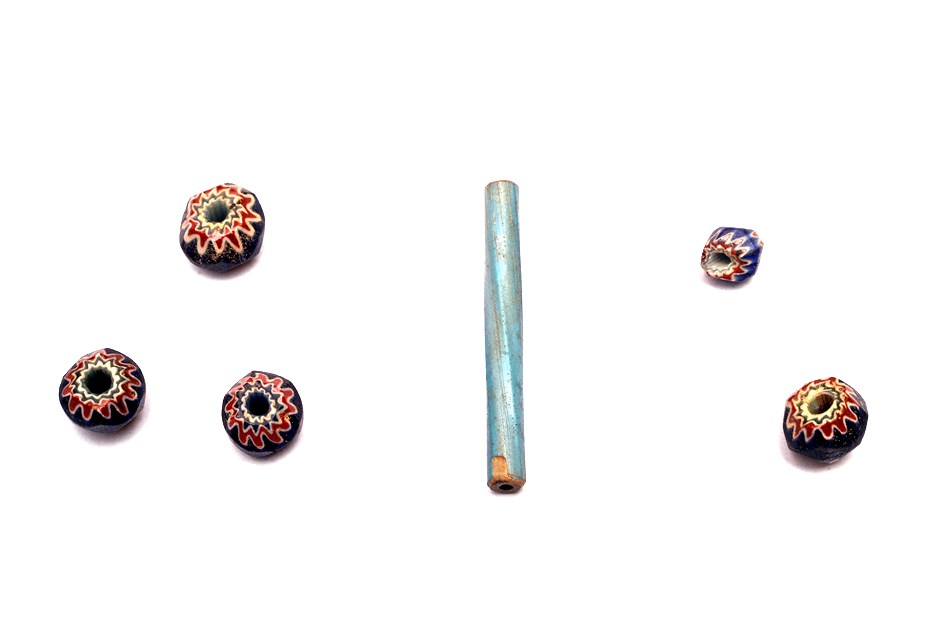
The glass beads on the right are colored Spanish glass trade beads from the 1500s. UWF found the beads on the surface of the East Pensacola Heights Site. UWF claims that they are from the Luna Colony of 1559. That is
incorrect. The bead assemblage of faceted chevrons and Nueva Cadiz beads date prior to the Luna Expedition. The beads likely represent trade items from Spanish
expeditions prior to the Luna Colony. Likely these
artifacts and others were interred in the two Native burial mounds reported by the Smithsonian Institution in the 1800s and later bulldozed, flattened, and spread out over the ground in the 1940s for residential development.
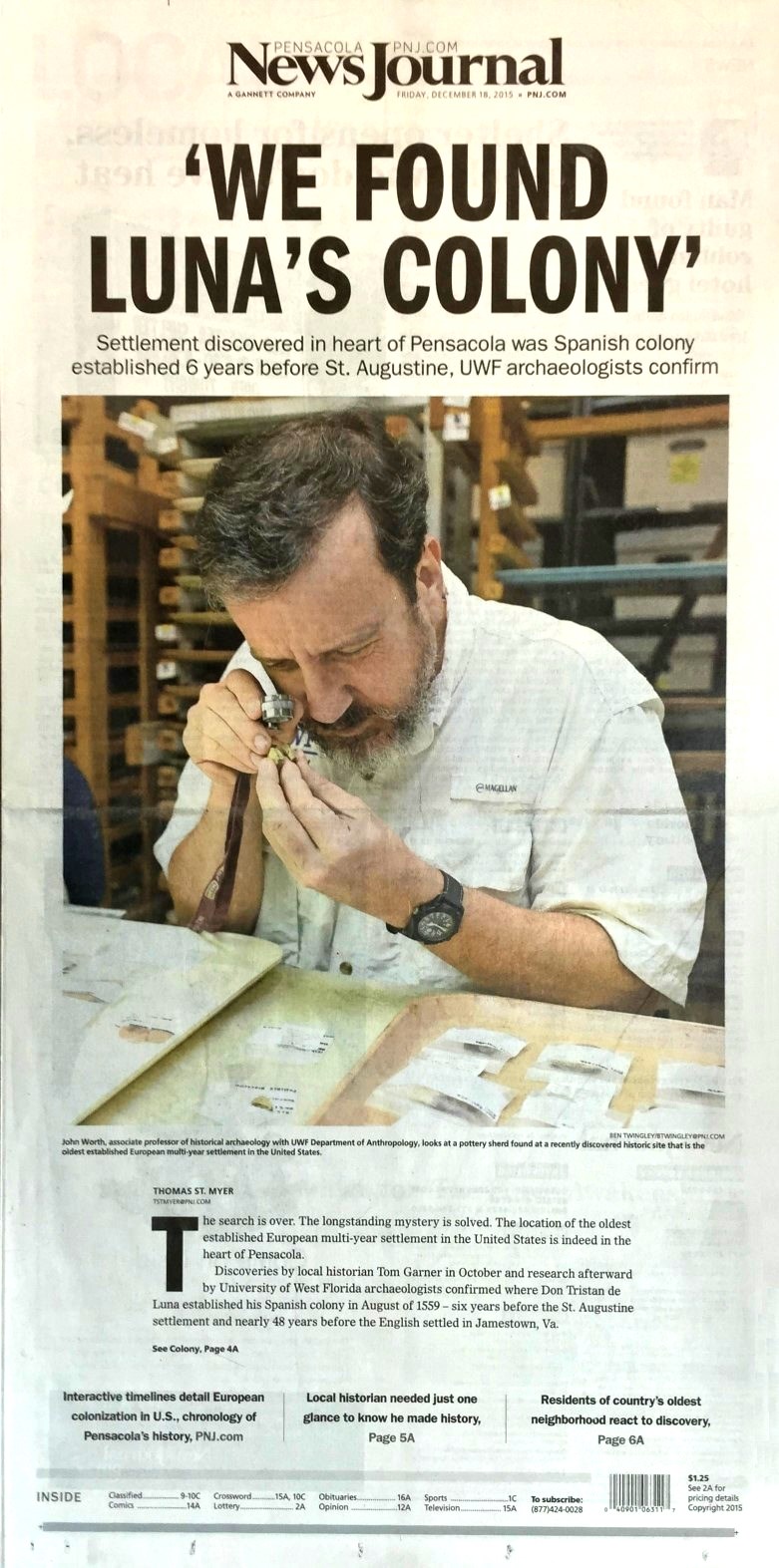
Only weeks after finding Spanish artifacts on the surface of the East Pensacola Heights Site, UWF started a media campaign to claim that they had found the
location of the Luna Colony. They had no irrefutable remains of Spanish features nor do they today after seven years of excavations. The University of West Florida might have stumbled upon the Luna Colony but for now they have absolutely no substantial proof of that, despite what they continue to claim.
Santa Elena and St. Augustine archeological features from the 16th-Century Spanish settlements on the eastern coast of the United States are illustrated on the following pages.
No such archeological features have been found at the University of West Florida “alleged” 16th-Century Luna Colony site on Pensacola Bay. Some 1,500 colonists with their many animals went ashore at their colony site. The Spanish maintained a presence at the settlement for over two years. Certainly prominent archeological features should be present at the site, wherever it is located.

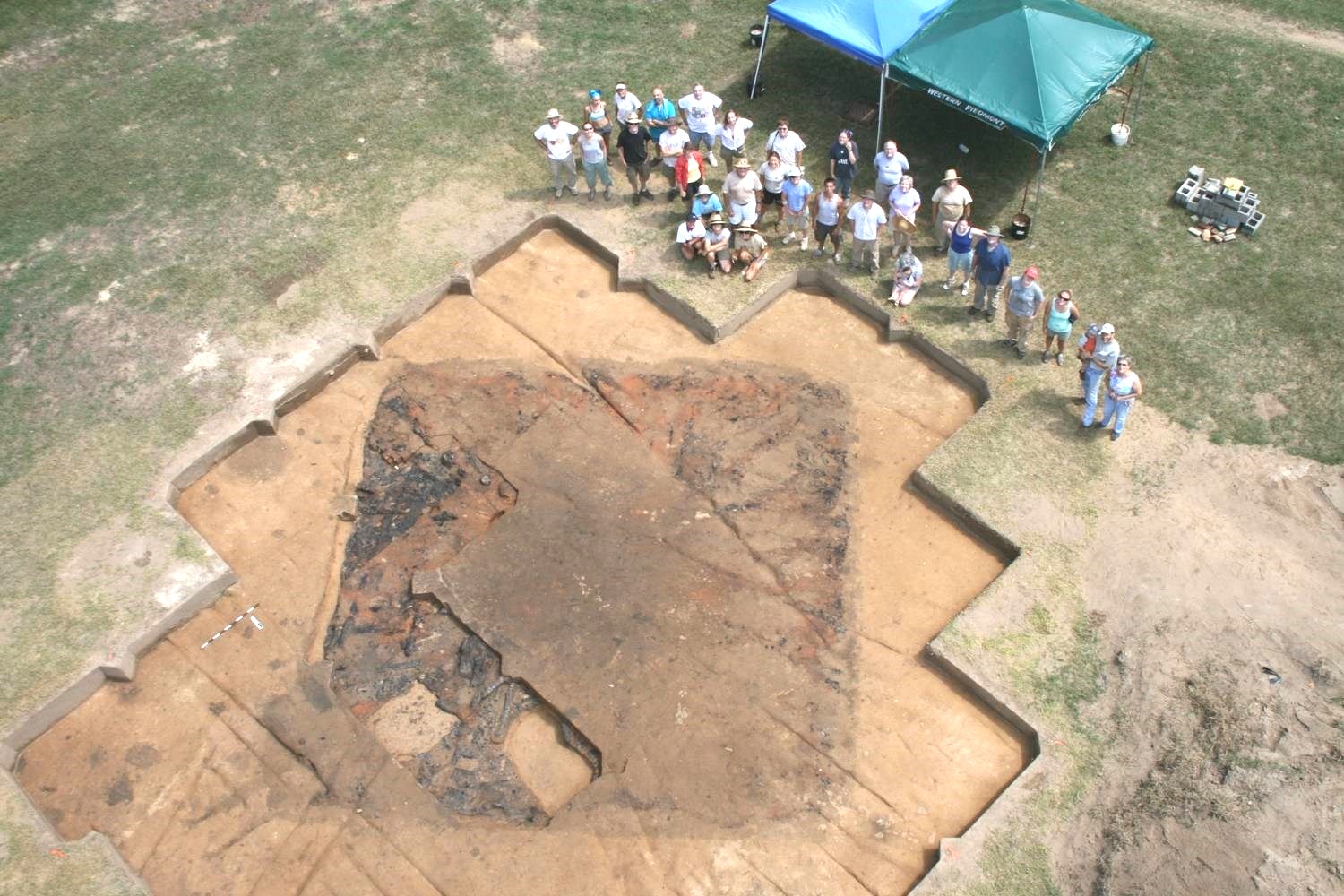
The Spanish house structure from the Santa Elena Settlement in South Carolina is remarkable. It is an example of what should be found at the East Pensacola Heights Site. The University of West Florida has not found anything that even resembles this type of feature yet their media campaign continues.

Spanish burial from the St. Augustine Site (1500s). Many people died during the Luna
Expedition. They would have been buried. No Spanish burials have been found on the UWF alleged Luna Colony Site … yet their media campaign continues without the
foundation of solid archeological hard data.

Spanish burial from the St. Augustine Site (1500s). Many people died during the Luna
Expedition. They would have been buried. No Spanish burials have been found on the UWF alleged Luna Colony Site … yet their media campaign continues without the
foundation of solid archeological hard data.
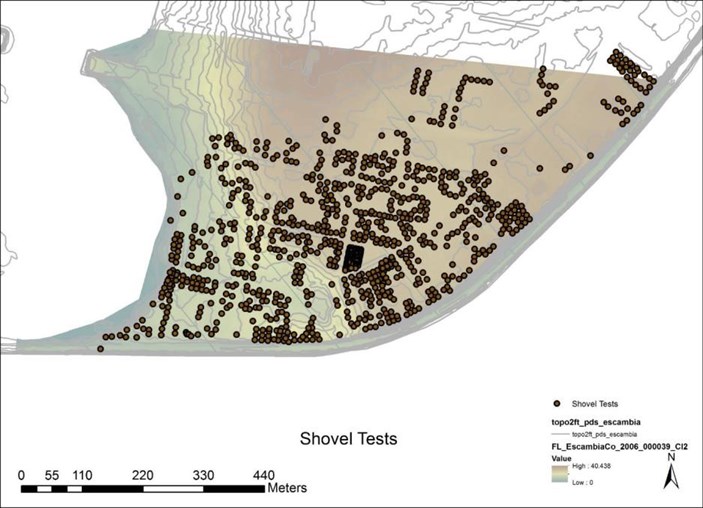
This is a map of the excavations of the University of West Florida. The excavation units are noted in black. UWF has conducted three more years of investigations at the site since this 2019 map so the total number of excavations have increased substantially. This is a
remarkable amount of excavations to not have found subsurface
features such as those at 16th-Century Santa Elena and St. Augustine.
The University of West Florida has not found the requisite
archeological data to prove the presence of the Luna Colony Site
despite seven years of excavations. It is still currently a hypothesis, not a scientific fact.
No amount of media blitz can cover up this fact.